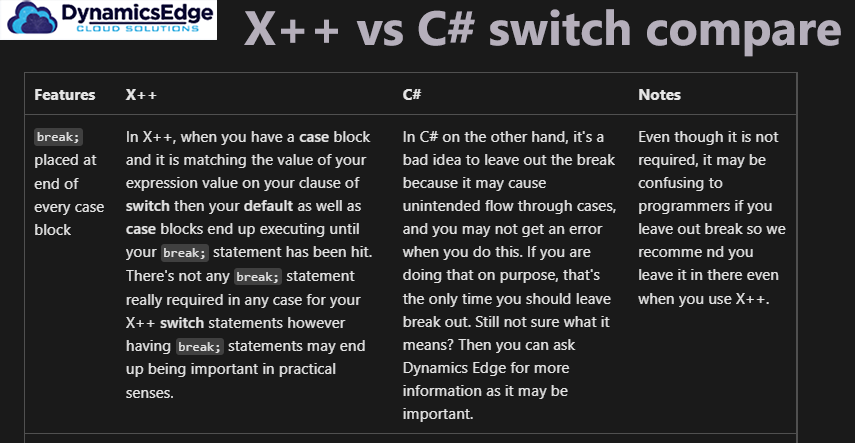UPDATE July 2025: See updated version of this article: X++ vs C# comparison July 2025 for more up to date info and details.
When you do an X++ and C# comparison first off X++ is a language in Microsoft Dynamics 365 Finance and Operations ERP suite which has origins in Dynamics Axapta or AX. C# is usually used in other places like .NET development, Dynamics CRM extension and programming and more. Ask Dynamics Edge about our custom C# development consulting and solution options to go more into the differences, but here’s a quick overview.

In both the X++ programming language and in C# coding for developers, your switch statement usually has to do with the keywords of default, case, as well as break. However there’s key differences too.
In X++ switch when you have a case block and it is matching the value of your expression value on your clause of switch then your default as well as case blocks end up executing until your break; statement has been hit. There’s not any break; statement really required in any case for your X++ switch statements however having break; statements may end up being important in practical senses.
In C# on the other hand, it’s a bad idea to leave out the break statement because it may cause unintended flow through cases, and you may not get an error when you do this. If you are doing that on purpose, that’s the only time you should leave break out. Still not sure what it means? Then you can ask Dynamics Edge for more information as it may be important for some scenarios to know more about it.
Even though it’s not required, it may be confusing to programmers if you leave out break so we recommend you leave it in there even when you use X++.
In X++ the break; statement is not required at default block’s end, but in C# it may be required by the compiler.
X++ lets you have either literal values or even variables such as case myVariable : – in C# you can only have literal values in cases, not any variables.
In X++ you can have comma separated values as multiple values to consider on same case block such as case 1,2,3,myIntVariable : but you cannot do that in C# you can just have case 1 : for example.
In X++ it is a better practice to go ahead and write in more than one value on one particular case block compared to leaving out the break; altogether in multiple blocks because it’s more concise and less confusing for the programmer – and some other languages do allow multiple case blocks, but leaving out the break; can be more confusing for many programmers even (and maybe especially) those who may have experience in more than one programming language.
You may also be wondering about x++ vs ++x in C# and other languages which has a key difference which is prefix vs postfix operator on the return value of the statement is with adding or incrementing 1 to the value in the variable first before returning for ++x and it would be without adding one first x++ when you log it or check its return value directly. When it appears in for loops though, is there a performance penalty for x++ vs ++X and the answer is that actually it’s almost identical because even in languages like C++, the assembly language version usually just has a different order in most cases for compilers and it’s not necessarily that postfix is better than prefix. x++ is the postfix increment operator, ++x is the prefix increment operator.
For more information on how you can be better prepared to boost your career in $100k-$200k D365 F&O jobs March 2025 and all year long, in some specific cases four figures for really huge roles you can please check out Microsoft MB-500 training for some more details on it.
Have a Question ?
Fill out this short form, one of our Experts will contact you soon.
Talk to an Expert Today
Call Now